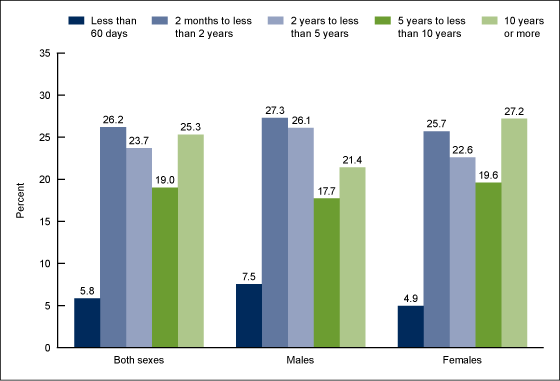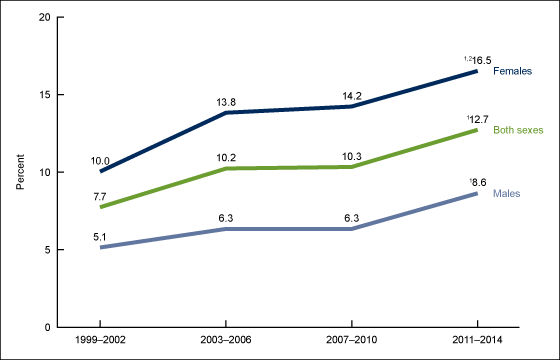Antidepressant Use Among Persons Aged 12 and Over: United States, 2011–2014
On This Page
- Key findings
- In 2011–2014, 12.7% of persons aged 12 and over reported antidepressant medication use in the past month.
- During 2011–2014, non-Hispanic white persons were more likely to take antidepressant medication in the past month compared with other race and Hispanic groups.
- One-fourth of persons who took antidepressant medication in the past month had been doing so for 10 years or more.
- Antidepressant use increased from 1999 to 2014.
- Summary
- Definitions
- Data source and methods
- About the authors
- References
- Suggested citation
NCHS Data Brief No. 283, August 2017
PDF Version (392 KB)
Laura A. Pratt, Ph.D., Debra J. Brody, M.P.H., and Qiuping Gu, M.D., Ph.D.
Key findings
Data from the National Health and Nutrition Examination Survey
- During 2011–2014, 12.7% of persons aged 12 and over, 8.6% of males, and 16.5% of females took antidepressant medication in the past month.
- For both males and females, non-Hispanic white persons were more likely to take antidepressant medication compared with those of other race and Hispanic-origin groups.
- One-fourth of persons who took antidepressant medication had done so for 10 years or more.
- Antidepressant use increased from 1999 to 2014.
Antidepressants are one of the three most commonly used therapeutic drug classes in the United States (1). While the majority of antidepressants are taken to treat depression, antidepressants can also be taken to treat other conditions, like anxiety disorders. This Data Brief provides the most recent estimates of antidepressant use in the U.S. noninstitutionalized population, including prevalence of use by age, sex, race and Hispanic origin, and length of use. This report also describes trends in the prevalence of antidepressant use from 1999–2002 to 2011–2014.
Keywords: depression medication, prescription drugs, NHANES
In 2011–2014, 12.7% of persons aged 12 and over reported antidepressant medication use in the past month.
- Overall and in each age group, females were about twice as likely as males to take antidepressant medication (Figure 1).
- Overall, antidepressant use increased with age, from 3.4% among persons aged 12–19 to 19.1% among persons aged 60 and over. Increased use with age occurred among both males and females.
Figure 1. Percentage of persons aged 12 and over who took antidepressant medication in the past month, by age and sex: United States, 2011–2014

1Statistically significant trend by age.
2Significantly lower than females in all age groups.
3Significantly lower than the older age groups.
4Each age group is significantly different from all other age groups.
NOTE: Access data table for Figure 1.
SOURCE: NCHS, National Health and Nutrition Examination Survey, 2011–2014.
During 2011–2014, non-Hispanic white persons were more likely to take antidepressant medication in the past month compared with other race and Hispanic groups.
- Among persons aged 12 and over, non-Hispanic white persons were five times more likely than non-Hispanic Asian persons to have taken antidepressant medication in the past month (16.5% compared with 3.3%) and three times more likely than Hispanic (5.0%) and non-Hispanic black (5.6%) persons (Figure 2).
- Females in every race and Hispanic-origin group were significantly more likely than males of the same race and Hispanic-origin group to have taken antidepressant medication.
- More non-Hispanic white females took antidepressants than females of any other race and Hispanic-origin group.
Figure 2. Percentage of persons aged 12 and over who took antidepressant medication in the past month, by sex and race and Hispanic origin: United States, 2011–2014

1Significantly lower than all other race and Hispanic-origin groups.
2Significantly higher than all other race and Hispanic-origin groups.
3Significantly lower than females in each race and Hispanic-origin group.
4Significantly higher than non-Hispanic Asian females.
NOTE: Access data table for Figure 2.
SOURCE: NCHS, National Health and Nutrition Examination Survey, 2011–2014.
One-fourth of persons who took antidepressant medication in the past month had been doing so for 10 years or more.
- During 2011–2014, 68.0% of persons aged 12 and over who took antidepressant medication had been taking antidepressants for 2 years or more (Figure 3).
- During 2011–2014, 21.4% of males and 27.2% of females had been taking antidepressant medication for 10 years or more.
- There were no statistically significant differences between males and females in the length of antidepressant use.
Figure 3. Length of antidepressant use among persons aged 12 and over, by sex: United States, 2011–2014

NOTE: Access data table for Figure 3.
SOURCE: NCHS, National Health and Nutrition Examination Survey, 2011–2014.
Antidepressant use increased from 1999 to 2014.
- Antidepressant use in the past month increased overall, from 7.7% in 1999–2002 to 12.7% in 2011–2014 (Figure 4).
- The percentage increase in antidepressant use over time was similar among males and females.
- Females were approximately twice as likely as males to have taken antidepressant medication at all time points.
Figure 4. Trends in antidepressant use among persons aged 12 and over, by sex: United States, 1999–2014

1Significant increasing trend.
2Significantly higher than males for all years.
NOTE: Access data table for Figure 4.
SOURCE: NCHS, National Health and Nutrition Examination Survey, 1999–2014.
Summary
During 2011–2014, about one in eight Americans aged 12 and over reported taking antidepressants in the previous month. Antidepressant use increased with age and was twice as common among females as males. Non-Hispanic white persons were more likely to take antidepressants than non-Hispanic black, Hispanic, and non-Hispanic Asian persons.
Long-term antidepressant use was common. One-fourth of all people who took antidepressants in the past month reported having taken them for 10 years or more.
Antidepressant use increased nearly 65% over a 15-year time frame, from 7.7% in 1999–2002 to 12.7% in 2011–2014. This increase was similar among males and females. At every time point, females were about twice as likely as males to report antidepressant use in the past month.
Definitions
Antidepressant medication: Prescription drugs were classified based on the three-level nested therapeutic classification scheme of Cerner Multum’s Lexicon (2). Antidepressants were identified using the second level of drug categorical codes, specifically code 249.
Length of use of antidepressants: Evaluated by asking participants how long they had been taking the medication. Among persons taking more than one antidepressant, the one they had taken the longest was included in the data shown in (Figure 3).
Prescription drug use: National Health and Nutrition Examination Survey (NHANES) participants were asked if they had taken any prescription drug in the past 30 days. Those who answered “yes” were asked to show the interviewer the medication containers of all prescription drugs. For each drug reported, the interviewer recorded the product’s complete name from the container.
Data source and methods
This report is based on the analysis of data from the 14,034 persons aged 12 and over who participated in the NHANES 2011–2014 household interview. Of these participants, 13,951 persons gave information on medication usage. Questions were administered in English and Spanish.
NHANES is a continuous survey conducted to assess the health and nutrition of the American people. The survey is designed to be nationally representative of the U.S. civilian noninstitutionalized population. Survey participants complete a household interview and visit a mobile examination center for a physical examination and private interview. The annual interview and examination sample includes approximately 5,000 persons of all ages.
For 2011–2012 and 2013–2014, non-Hispanic black, non-Hispanic Asian, and Hispanic persons were oversampled to obtain reliable estimates for these population subgroups. Specific race and Hispanic-origin estimates reflect persons reporting only one race. Those reporting “other” race or more than one race are included in all figures except (Figure 2), where they are not reported separately.
NHANES sample interview weights, which account for the differential probabilities of selection, nonresponse, and noncoverage were used for all analyses. Standard errors of the percentages were estimated using Taylor series linearization, a method that incorporates the sample design and weights.
Overall differences between groups were evaluated using the chi-square statistic. Where the chi-square test was significant, differences between subgroups were evaluated using the univariate t statistic. A test for linear trends was done to evaluate changes in the estimates by age in (Figure 1) and over time in (Figure 4). All significance tests were two-sided 0.05-level tests, with no adjustment for multiple comparisons. All comparisons reported are statistically significant at the 0.05 level unless otherwise indicated. Data analyses were performed using SAS version 9.4 (SAS Institute, Cary, N.C.) and SUDAAN version 11.0 (RTI International, Research Triangle Park, N.C.).
About the authors
Laura A. Pratt is with the National Center for Health Statistics (NCHS), Office of Analysis and Epidemiology. Debra J. Brody and Qiuping Gu are with the NCHS Division of Health and Nutrition Examination Surveys.
References
- National Center for Health Statistics. Health, United States, 2015: With special feature on racial and ethnic health disparities. Table 80: Selected prescription drug classes used in the past 30 days, by sex and age: United States, selected years 1988–1994 through 2009–2012. Hyattsville, MD. 2016.
- Multum Lexicon Drug Database. In: National Health and Nutrition Examination Survey: 1988–2014 data documentation. Prescription medications–drug information (RXQ_DRUG). 2016. Available from: https://wwwn.cdc.gov/Nchs/Nhanes/1999-2000/RXQ_DRUG.htm.
Suggested citation
Pratt LA, Brody DJ, Gu Q. Antidepressant use among persons aged 12 and over: United States, 2011–2014. NCHS data brief, no 283. Hyattsville, MD: National Center for Health Statistics. 2017.
Copyright information
All material appearing in this report is in the public domain and may be reproduced or copied without permission; citation as to source, however, is appreciated.
National Center for Health Statistics
Charles J. Rothwell, M.S., M.B.A., Director
Jennifer H. Madans, Ph.D., Associate Director for Science
Office of Analysis and Epidemiology
Irma E. Arispe, Ph.D., Director
Makram Talih, Ph.D., Associate Director for Science
Division of Health and Nutrition Examination Surveys
Kathryn S. Porter, M.D., M.S., Director
Ryne Paulose-Ram, Ph.D., Associate Director for Science
- Page last reviewed: August 15, 2017
- Page last updated: August 15, 2017
- Content source:


 ShareCompartir
ShareCompartir